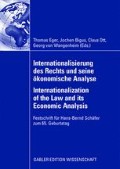Abstract
On June 28, 2007, the US Supreme Court decided in the ‘Leegin’ case1 that resale price maintenance should no longer be per se prohibited in US antitrust law. Beginning with GTE Sylvania (1977) the court has reversed former per se prohibitions of vertical restraints and replaced them step by step through a rule of reason approach, as now for resale price maintenance. This development follows a more positive and differentiated assessment of vertical restraints by economists. Since it can be demonstrated that under certain conditions resale price maintenance might also be welfare-enhancing, many economists think that a per se prohibition is no longer appropriate (Motta 2004, 377). The general debate about ‘per se rules vs. rule of reason’ in US antitrust law is nearly as old as the law itself. Whereas a per se prohibition means that a business behavior is forbidden per se, i.e. without considering the specific circumstances in a case, a rule of reason approach allows for a much more differentiated analysis of the circumstances and effects in that particular case. In the last two decades — not only in the US, but also in Europe — a growing tendency to more rule of reason instead of per se rules can be observed. The main reason for this development is the insight of modern industrial economics that many business behaviors do not have generally positive or negative effects on competition or welfare. Often a greater differentiation and a deeper analysis of the circumstances and effects seem necessary for distinguishing between pro- and anticompetitive behaviors (Kerber and Schwalbe 2008, 230–235). A rule of reason analysis appears to be more appropriate. These developments also are the basis of the ‘more economic approach’ in European competition policy (Röller 2005). In combination with new theoretical and empirical methods for the quantitative analysis of the welfare effects this has led to a tendency for a greater case-by-case approach.
Leegin Creative Leather Products Inc vs. PSKS Inc., 551 U.S. (2007), Sup Ct (USA).
Access this chapter
Tax calculation will be finalised at checkout
Purchases are for personal use only
Preview
Unable to display preview. Download preview PDF.
References
Christiansen, A., and W. Kerber (2006): Competition Policy with Optimally Differentiated Rules Instead of “Per se Rules vs. Rule of Reason”, Journal of Competition Law and Economics 2(2), 215–244
Crane, D.A. (2007): Rules versus Standards in Antitrust Adjudication, Washington and Lee Law Review 64, 49–110
Diver, C.S. (1983): The Optimal Precision of Administrative Rules, The Yale Law Journal 93(1), 65–109
Easterbrook, F.H. (1992): Ignorance and Antitrust, in: Jorde, T.M. and D.J. Teece (eds.), Antitrust, Innovation, and Competitiveness, New York: Oxford University Press, 119–136
Ehrlich, I. and R.A. Posner (1974): An Economic Analysis of Legal Rulemaking, Journal of Legal Studies 3, 257–286
Eucken, W. (1952): Grundsätze der Wirtschaftspolitik, Tübingen: Mohr Siebeck
Fon, V., and F. Parisi (2007): On the Optimal Specificity of Legal Rules, Journal of Institutional Economics 3(2), 147–164
Hayek, F.A. (1973): Law, Legislation, and Liberty, Vol. I: Rules and Order, Chicago: Chicago University Press
Heyer, K. (2005): A World of Uncertainty: Economics and the Globalization of Antitrust, Antitrust Law Journal 72(2), 375–422
Joskow, P.L. (1992): Transaction Costs Economics, Antitrust Rules, and Remedies, Journal of Law, Economics, and Organization 18(1), 95–116
Kaplow, L. (1992): Rules versus Standards: An Economic Analysis, Duke Law Journal 42, 557–629
Kaplow, L. (1995): A Model of the Optimal Complexity of Legal Rules, Journal of Law, Economics, and Organization 11(1), 150–163
Kaplow, L. (2000): General Characteristics of Rules, Encyclopedia of Law and Economics, 502–528
Kerber, W., and U. Schwalbe (2008): Economic Principles of Competition Law, in: Säcker, F.-J., Hirsch, G., and F. Montag (eds.), Competition Law: European Community Practice and Procedure-Article-by-article Commentary of the EC Competition Law, Vol. 1, London: Sweet & Maxwell, 202–391
Motta, M. (2004): Competition Policy. Cambridge: Cambridge University Press
Parisi, F. (2004): Rules versus Standards, in: Rowley, C.K., and F. Schneider (eds.), Encyclopedia of Public Choice, Dordrecht: Kluwer Academic Publishers, 510–516
Parisi, F., Fon, V., and N. Ghei (2004): The Value of Waiting in Lawmaking, European Journal of Law and Economics 18, 131–148
Röller, L.-H. (2005): Economic Analysis and Competition Policy Enforcement in Europe, in: van Bergejik, P.A.G., and E. Kloosterhuis (eds.), Modelling European Mergers. Theory, Competition Policy and Case Studies, Cheltenham: Elgar, 11–24
Schäfer, H.-B. (2006): Rules versus Standards in Rich and Poor Countries: Precise Legal Norms as Substitutes for Human Capital in Low-Income Countries, Supreme Court Economic Review 14, 113–134
Sullivan, K.M. (1992): The Justices of Rules and Standards, Harvard Law Review 106, 22–123
Vanberg, V. (2005): Market and State: The Perspective of Constitutional Political Economy, Journal of Institutional Economics 1, 23–49
Van den Bergh, R.J., and P.D. Camesasca (2006): European Competition Law and Economics. A Comparative Perspective, London: Sweet & Maxwell
Author information
Authors and Affiliations
Editor information
Rights and permissions
Copyright information
© 2008 Gabler | GWV Fachverlage GmbH, Wiesbaden
About this chapter
Cite this chapter
Kerber, W. (2008). ‘Rules vs. Standards’ or Standards as Delegation of Authority for Making (Optimally Differentiated) Rules. In: Eger, T., Bigus, J., Ott, C., von Wangenheim, G. (eds) Internationalisierung des Rechts und seine ökonomische Analyse. Gabler. https://doi.org/10.1007/978-3-8350-5582-7_36
Download citation
DOI: https://doi.org/10.1007/978-3-8350-5582-7_36
Publisher Name: Gabler
Print ISBN: 978-3-8350-0877-9
Online ISBN: 978-3-8350-5582-7
eBook Packages: Business and Economics (German Language)

